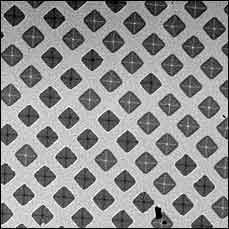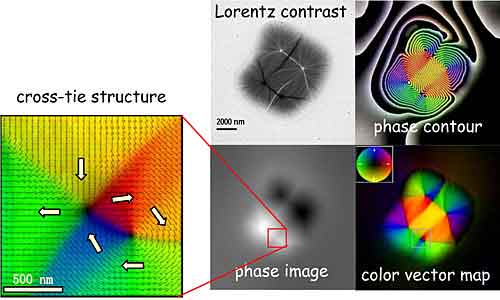| Mar 13, 2006 |
Shrinking Magnetic Storage Media Down to the Nanoscale
|
|
(Nanowerk News) In the world of electronic and magnetic devices, the goal is to get smaller. "The smaller space one bit of information can occupy, the more data you can get into a device and the faster it can operate," says Yimei Zhu, a senior scientist at the U.S. Department of Energy’s Brookhaven National Laboratory. Zhu will present his work assessing the properties of materials that may lead to magneto-electronic devices on the scale of billionths of a meter at the American Physical Society meeting in Baltimore, Maryland, on Monday, March 13, 2006.
|
|
Zhu’s group has fabricated patterned magnetic films by depositing magnetic materials such as Permalloy and cobalt in patterns of dots, squares, or ellipses across a surface of nonmagnetic substrates such as carbon or silicon nitride. With each dot measuring about 100 nanometers, these materials could serve as building blocks for new nanoscale magneto-electronic devices and data storage media.
|

|
Pattern of magnetic squares showing two distinct polarities in black and white. (Source BNL)
|
|
"For digital communication and data storage applications, such as magnetic recording media, you need two stable states to encode the ‘ones’ and ‘zeros’ of digital information," Zhu explains. In his array of magnetic dots, the two states are the two distinct spin orientations, or polarities, of the dots’ internal magnetic fields.
|
|
Using a state-of-the-art, field-emission transmission electron microscope (TEM) equipped with a custom-made objective lens – the only one like it in the world – Zhu’s group can probe the magnetic properties (including spin orientation) of each dot, and map how the spins "flip" in response to an external magnetic field – or other variables such as temperature, environment, and crystal defects. The technique uses an extremely coherent source of electrons to produce images with unprecedented quality at high resolution in which the amplitude and direction of local magnetization can be clearly visualized.
|

|
| An individual magnetic element showing local magnetization under an applied field via magnetic phase imaging and reconstruction methods. (Source: BNL)
|
|
"What we are looking for is two very stable states with a well-defined switching mechanism," Zhu says. Such a medium could be encoded with digital data by switching the spins from "up" to "down" – or clockwise to counterclockwise – at will, without interference from other variables.
|
|
"In order to make these materials into useful, practical magnetic building blocks, we really have to understand this switching, or reversal, mechanism," Zhu says.
|
|
The precise measurements allow the scientists to compare experimental observations with calculations to validate various theoretical models.
|
|
Once the researchers understand the mechanism, scientists may be able to scale the materials down even smaller, perhaps to the molecular scale.
|
|
Zhu’s talk will take place on Monday, March 13, 2006 at 2:54 p.m. in Room 319 of the Baltimore Convention Center. This research was funded by the Office of Basic Energy Sciences within the U.S. Department of Energy’s Office of Science.
|


